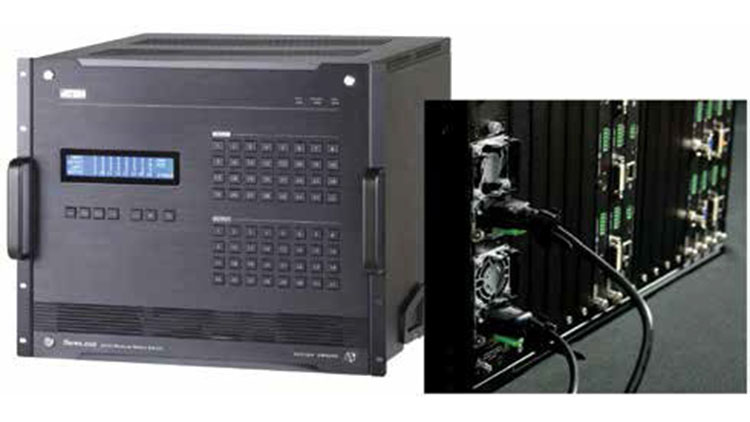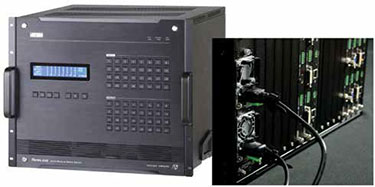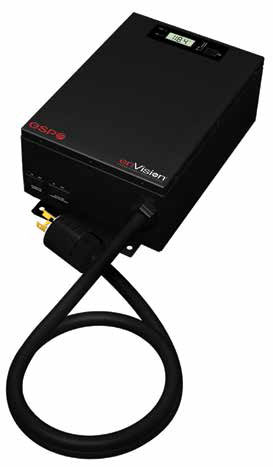New Tech to Manage Your Cabling, Power Delivery Needs

To the end user, AV is all about the splash of mega LED screens, the immediacy of interconnectivity, and the blue sky of an interactive future.
Integrators know the real lifeline of the AV ecosystem is the often complex backend, a labyrinth of power and data cables tied into racks of black boxes that bring the eye candy to life. Managing the extensive cabling and power delivery needs of AV systems today involves innovations in components small and large, intelligent software, and even big data.

Noel Lo, ATEN
“End customers in the professional AV space often face similar problems that need to be addressed,” said ATEN Technology channel marketing manager Noel Lo, citing power failures, voltage spikes, and power surges that can damage AV equipment among top concerns.
Chasing electrical gremlins through the installation grid is no integrator’s idea of a good time. The best defense against power management problems happens at the beginning of a project or installation. Ensuring the proper protection equipment is specified upfront is part of a solid AV system foundation, minimizing service calls, and even preventing catastrophic failures.
But while preventative best practices are the right prescription for trouble-free installations, having an understanding of the system’s technology and its limitations can guide integrators to the right power components for the system.

Lauren Simmen, AMETEK Electronic Systems Protection
A daily selection of the top stories for AV integrators, resellers and consultants. Sign up below.
“Sometimes, the technology used within these power management systems can be the root cause of their vulnerabilities,” said Lauren Simmen, marketing manager at AMETEK Electronic Systems Protection.
“Many devices employ sacrificial means of protection against surges, using metal oxide varistors (MOV) technology to protect against surges by absorbing the energy. Unfortunately, this method of protection still allows surge energy to pass through to the device. MOVs, being sacrificial in nature, will wear out—and once those are gone, AV integrators are left with nothing protecting the equipment they’ve installed.”
Simmen said AMETEK deploys a non-sacrificial method of protection for up to 6,000 volts of surge energy across its SurgeX product line.
The spectrum of system vulnerabilities can also include literal device meltdown. The assorted equipment, large and small, tied into AV systems largely relies on the same “wall wart” type of power adaptors, which convert 120-volt current to much lower voltages. When these adaptors wear out, the device and anything downstream fails, leading to system-wide troubleshooting scavenger hunts.

Steven Barlow, DVI Gear
“You have a small wall wart that can put out a decent amount of power, depending on the design, but that power also means heat,” said Steven Barlow, president at DVIGear. “Over the years, the components inside that little black power-supply case can gradually heat up and dry out, and then it fails.”
Another nuisance with power supplies, he said, is the outsized real estate they take up in the backroom. “You only have so many AC outlets inside a rack, and adding more [power supplies] just makes the rack messy and cumbersome.”
DVIGear developed a line of 1U, half-rack power distribution units that take AC power and distribute it to eight Phoenix outputs in 5-volt or 12-volt configurations. The units enable a smaller and tidier footprint.
“The outputs of these are fairly high current, so it’s completely possible to double or even triple the output port if you needed to with the current handling capacities of these power supplies,” Barlow said. As large-format visual displays become more common, the need for higher power transmission over cable is increasing.
One of the biggest shifts in AV cabling is combining power delivery and signal delivery over the same line, particularly with Power over Ethernet (PoE) and HDBaseT (PoH). For devices with low-power needs under 30 watts, PoE is the preferred protocol. PoH, however, can transmit up to 100 watts. In addition, HDBaseT enables power sending and receiving devices to communicate data and distance in order to deliver the appropriate amount of power.
“Today you have the possibility to deliver over 100 watts of power over a twisted pair cable that’s also delivering the HDBaseT signal,” said Barlow. “That’s really convenient because you actually have displays and some projectors that need modest or more than modest levels of power that can actually be powered over the HDBaseT connection.”
Added Lo, “A savvy AV integrator can choose PoH to reduce cable usage, saving space for power adapters and power outlets to accomplish clean and uncluttered installations.”

ATEN’s VM3200 32x32 Modular Matrix Switch with hot-swappable redundant power supply.
While HDBaseT has become a successful AV cabling protocol, DVIGear and other companies are looking for Active Optical Cables (AOC) to grow in acceptance in AV installations. “This AOC is a really ideal cable,” said Barlow. “It’s very lightweight, very flexible. It’s not as inexpensive as a copper cable but it’s not near as expensive as the optical cables of earlier years.
Barlow continued, “They’re available in long lengths, so I don’t need an HDBaseT transmitter or receiver—I simply buy one cable and connect it. They’re very low power so I don’t need a power supply to energize the electronics in the cable. It’s all done from the source device.”
Access to data, even on a local scale, is helping integrators manage AV installations. System wide, data is becoming more important as the number of managed services rise, and diagnostic and monitoring tools are helping locate system vulnerabilities.
“Access to data is the number one need we see changing in AV installations,” said Simmen, citing feedback from both integrators and end users. “This is becoming more and more prevalent in power management and across the board. With access to more data comes the ability to create better, more efficient systems.”

AMETEK Electronic Systems Protection's 30-amp enVision measures power data, which includes line-neutral voltage, neutral-ground voltage, amperage, crest factor, power factor, line frequency and energy usage.
The ability to track fluctuations within a system’s power structure, as well as a growing interest in using that data to make informed or predictive decisions based on the incoming power environment is driving this shift, Simmen added.
AV manufacturers are already responding to this need. Intelligent power distribution units such as the ATEN PE6208AV provide a quick visual of power consumption in the rack environment, as well as temperature and humidity sensing.
SurgeX is putting its data research to use in the enVision diagnostic tool, which integrators can use to identify potential power issues. Once installed, it will monitor power conditions and help pinpoint power anomalies such as surges, spikes, or sags. The company’s Export Manager Software aids in identifying broader system vulnerabilities, giving integrators direct access to data logs and analytics that can help identify and fix what might be causing internal power problems.
“Access to the data is the first step,” said Simmen, “but being able to act on the data provided and predict or prevent problematic power conditions is one way we’re engineering our product lines to be more beneficial to integrators.”
Jim Beaugez, APR, is a freelance writer and accredited communications professional with a decade of experience in the MI and pro audio industries. You can reach him at jimbeaugez@gmail.com and on Twitter @JimBeaugez.
Jim Beaugez is a freelance writer and content creator for the AV, professional audio, and music industries. His work has been published by Systems Contractor News, Pro Sound News, Mix, Radio World, and The Recording Academy, as well as Rolling Stone, Smithsonian, Guitar World, Guitar Player, and other consumer publications. He previously worked in communications for the pro audio and musical instruments industries.
